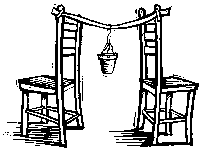Secrets of Lost Empires I—Inca
|  |
Student Handout |
Hang In There!
Would you cross a raging river 18 m (59 ft) below, knowing the
only thing that supported you was a bunch of grass? Using nothing but simple
blades of grass, Andean villagers built a suspension bridge strong enough to
support the weight of several people. Try building your own cables using strips
of newspaper.
Procedure
Cut the newspaper into 5 cm (2 in.) wide strips. Build a load tester to test how much weight the newspaper strips can hold.
Unfold four paper clips into "S" shapes. Punch three holes around the sides of the paper cup. Make sure the holes are spaced evenly just below the top of the cup. Slip a paper clip through each hole in the cup. Place a fourth paper clip through the other paper clips to make a hanger.

Place two chairs so that they are about 60 cm (2 ft) apart. Tape an end of a
newspaper strip securely to the top of each chair so that it sags slightly in
the middle. Hook the load tester to the center of the strip, and measure how
much weight the newspaper strip can hold until it breaks.

On a separate sheet of paper create a two-column chart to record your
results. Draw and describe the newspaper strip in the first column; record the
weight the strip can hold in the second column. Now invent ways to increase the strength of the newspaper strip. Try twisting
two strips together as the Inca did. Think of other methods to create other
kinds of cables. For each method you invent, describe it in your chart and
record the weight it holds. (As the weight increases, you can try hanging
heavier objects from the cable.)
Questions
Write your answers on a separate sheet.
Which cable design was able to support the most weight? Why? Which design could support the least? Why?
|